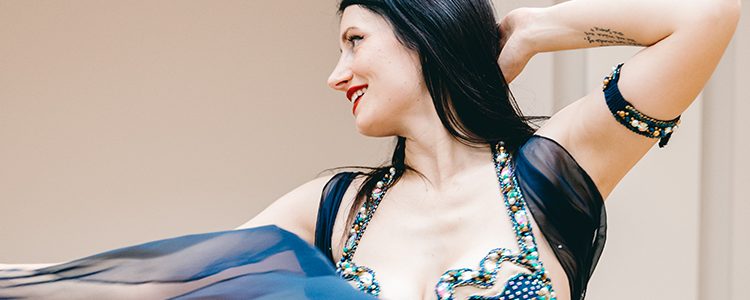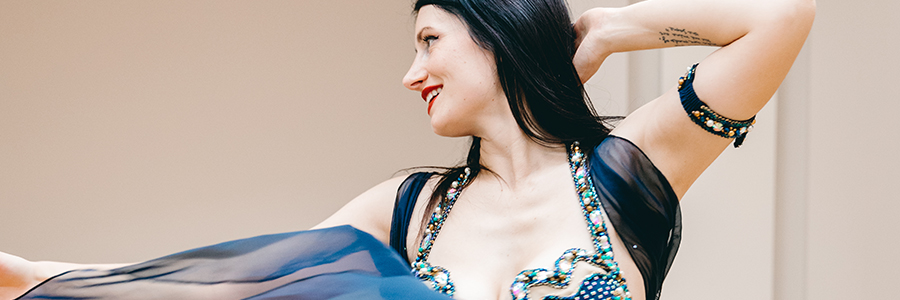
My Story
Everything is cyclical. I’ve come to realise that what goes around comes around. The shapes we form in belly dance are always based on soft, circles. The infinity symbol. Never ending shapes.
 As a teenager I used to go to belly dance workshops and festivals with my mum. On the surface disinterested, but with all the anxiety and self-consciousness of a teenager, I secretly wanted to be on the stage dancing. I used to draw and paint belly dancers, as well as spending hours on the website Shira (in the days of dial-up internet). I would shimmy and practise hip drops to Shakira, imagining working as a belly dancer. But these dreams lay forgotten, buried by the “real” world, responsibility and the need to earn money. Being a belly dancer was a joke.
As a teenager I used to go to belly dance workshops and festivals with my mum. On the surface disinterested, but with all the anxiety and self-consciousness of a teenager, I secretly wanted to be on the stage dancing. I used to draw and paint belly dancers, as well as spending hours on the website Shira (in the days of dial-up internet). I would shimmy and practise hip drops to Shakira, imagining working as a belly dancer. But these dreams lay forgotten, buried by the “real” world, responsibility and the need to earn money. Being a belly dancer was a joke.
I ended up in Egypt towards the end of 2019, not entirely by chance, but for reasons completely unrelated to dancing. My Egyptian friends moved back to Cairo and I hadn’t worked the travel bug out of my system. I thought screw it – I retrained as an English teacher, despite my misgivings about the spread of English as the language of the world; packed my bags and headed for Cairo. Four years later and I can’t quite cut the cord. Egyptians are the most hospitable and funniest people I’ve ever had the pleasure of teaching and knowing. Cairo feels like the place I grew into myself. But anyone who has lived abroad for long periods of time, knows the ups and downs of travel. It was wild – the second Arab spring very nearly happened during my first week. I know because I was in my hotel next to Tahrir square. The BBC was banned for reporting the events: “fake news.”
I intended to take belly dance classes whilst I was there, Egypt being one of the homes of this dance, but what I hadn’t anticipated was the reaction and encouragement of my native teachers, which was instant. All of them telling me that this music is in my blood and that I have real feeling. When you hear this from Egyptian teachers, that dancers have real feeling for the music. That is the greatest compliment of all. I learnt the defining features of Egyptian style – feeling, dalaa, cheekiness, relaxed, improvisation and how to differentiate between Western style shimmies and the Egyptian style. I spent hours in the dance studio, training my body.
Ten years ago, I participated in a write your own one person show course. The scratch night didn’t lead anywhere and honestly, I wasn’t ready. It was whilst recovering from life, and secretly terrified that I wouldn’t dance again, that I took a write your own one woman show course with Jane Postlewaite. Finally, able to start formulating my ideas, enough life experience to know who I am and what I believe. We learnt that the 40-minute mark of any comedy show, always features an emotional moment – but I didn’t know what it would be? Later that year, this was resolved by life and a month at home lead me to writing my show.
It was whilst teaching English for a few weeks in Chernitvsi, Ukraine, that I received the call that I was one of the recipients of the New Wave theatre programming. For me, it was the sign that finally I’m on the right path.
Trust the process and the universe. It might take 10 years, but those dreams and ideas, do eventually come to fruition. And the realisation, that your twenties are there for trying stuff and messing up and when you hit your thirties, actually this, is just the beginning.
Belly dancing in 2023
When I moved to Egypt in 2019, I knew I wanted to take belly dancing classes. Although we have a history of bellydance classes in the UK, this has been on a steady decline over the last fifteen years and it can be really hard to find a teacher, particularly if you live out in the sticks. When I was young, I was lucky to attend Brighton Orient, a festival where we learnt from well-known Egyptian teachers including Khaled Mahmoud.
I was a typically awkward teenager and never danced in public. I would dance for hours in my room, but as I got older I felt uncertain in my knowledge and wanted to learn this dance from the source. What really makes it Egyptian in style? What is real bellydancing? As a European, am I allowed to dance it? When I arrived in Cairo and started following bellydancers on Instagram, I couldn’t understand why it looked so different from the dance I had learnt as a teenager? Two things had happened: dance and music has evolved radically over the last ten years, partly due to the introduction of electronic sounds and Western style nightclubs, but also due to the huge influx in foreign dancers and global interest in this dance. And this external influence has definitely influenced changes in style.
One of my Egyptian friends very kindly supported me when I performed at my first ever online hafla two years ago. I was terrified. But she said afterwards, “Why do foreigners do so much stuff with their arms?” Egyptian style is much more focussed on the hips and soft and relaxed in styling. And I always question if someone really knows what this dance is, if they go to Egypt and say that Egyptian style is messy, which is something you unfortunately hear a lot from people who’ve learnt bellydance abroad.

When people watch belly dance in the West, they tend to want technique, drama and complex choreographies. That’s not the case in Egypt, they adore warm, funny and confident personalities. Egyptian style is usually improvised, relaxed and steeped in feeling. I’ve spent hours watching famous dancers such as Dandash and Dina. And it’s the dalaa and feeling which define Egyptian dance. It’s not how complicated the choreography is, it’s the emotions. Dalaa is something women in the Middle East naturally exude – it’s soft, sexy but shy: coy. In the West, we tend to apply Western dance rules to this dance, which whilst at times can be useful for developing technique, often this means the dance loses this soul.
People debate the style they prefer – classical oriental, modern oriental, baladi (more relaxed), shaabi and mahraganat (up to date, electronic music), but you can never argue with the quality of someone’s hip movements. It’s a dance routed in the pelvis. For me, this is still one of the most important aspects in the dance – juicy hip work that responds to the rhythm, particularly small internal movements. Last year, I went to a workshop by a well-known male teacher and he asked everyone to dance to the band whilst he watched. He stopped and asked – “why do you all keep turning? Where are the hip accents?”
The Western world also tends to bemoan the loss of the elegant, Golden Era style, which some consider more elegant. Whilst at times I agree that it would be great to see more oriental, tastes have changed and I feel really strongly that the current fashion for Mahraganat, is really important for Egypt as a country. This electronic style of music started on the street and is the disenfranchised finding a voice and means to express themselves. This dance is intrinsically linked to the cultures from which it has evolved, and learning more about the context allows the dancer to understand why things are changing and to develop their practice fully.
How to Run Away runs at the Crypt Gallery from Wed 18 – Fri 20 October at 9pm (Tickets: £8 (£6)).
Bellydance Workshop with Lucy Andrina is at Conway Hall on Sat 21 October at 10.30am (Tickets: £5).
